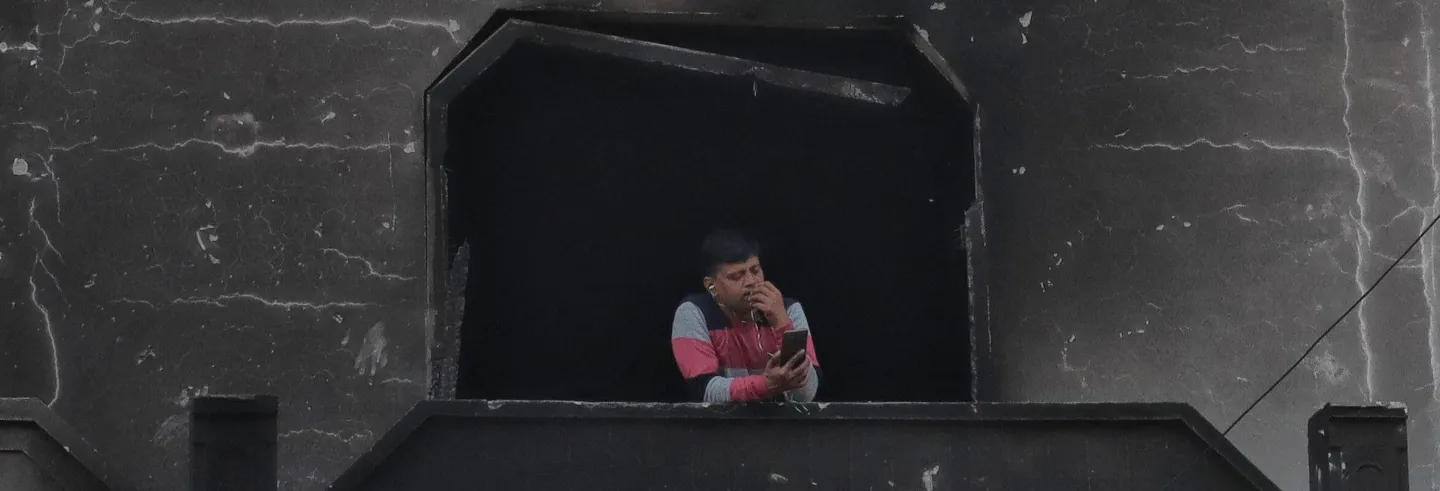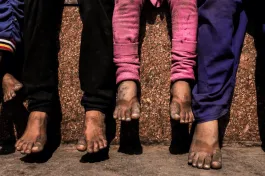S.F., a legal anthropologist, writes:
On 20 December 2019, Bharatiya Janata Party leader Kapil Mishra caught national attention when he appeared at a rally in north-east Delhi in support of the Citizenship Amendment Act (CAA) 2019. In the run-up to the legislation and after its passage in Parliament, Muslims in Delhi and elsewhere, supported by others, had come out in numbers to protest the act as they feared it was a prelude to strip them of citizenship.
That December day, Mishra proclaimed in Hindi at a public meeting “desh ke gaddaron ko, goli maaron saalon ko,” loosely translated as “shoot the damn traitors of the nation.” Weeks later union minister Anurag Thakur egged on participants at an election poll rally in Delhi to raise the same slogan. Soon the politicians’ words began to take on a life of their own. Government supporters raised the slogan as they protested in the streets, in front of Muslim educational institutions, and near gatherings in support of the CAA. The situation escalated in late February 2020, when Hindu mobs, largely unhindered by the Delhi police, systematically burnt down Muslim homes and businesses, attacking and even killing Muslims – the ‘traitors’.
Commentators observed that the slogan met the Indian Supreme Court’s criteria for hate speech as it promoted enmity against a particular religious group. According to some international scholars, a number of speeches made by public personalities between December 2019 and April 2022 may have also amounted to incitement to genocide under international criminal law. Nonetheless, the politicians who mobilised the slogans and the police officers who neglected to intervene in the riots escaped criminal proceedings. Mishra himself denied responsibility and said he had not instigated violence against Muslims. Other BJP politicians agreed: how supporters interpreted slogans, they stated, was outside their control.
Acts of hate and discrimination are like slippery fish, which slide out of the legal evidence net the harder you try to catch them.
In one sense, the reason for this lack of legal consequences is simple. The police and courts do not stand apart from politics. These institutions have often used their discretion to invisibilise their crimes. (Bhat, Bajaj, and Kumar 2020). But the unfolding judicial responses to the riots during the CAA agitation highlighted something beyond the brute manner that criminal prosecution can bow down to state power: the power of strategic silences and coded language in hiding hate.
In legal terms, acts of hate and discrimination are like slippery fish, which slide out of the legal evidence net the harder you try to catch them. The ambiguity of hate speech stems from the symbolism and the quietude through which people communicate prejudice and hostility. Perpetrators of hate tap into collective memories of oppression that circulate in a particular cultural and historical environment to communicate hostility publicly. They do so by utilising analogies, symbols, comparisons and rhetoric devices, which socially dominant groups in their cultural context have used for generations to illustrate the inferiority of minorities. Perpetrators of hate draw on these codes to effectively put marginalised groups in their place without stating their views explicitly.
With an escalation of violence against religious minorities and lower castes over the past decade, civil society groups have called for the introduction of comprehensive hate crime legislation to punish identity-based crimes against all of India’s historically marginalised groups (Citizens Against Hate 2018a). But simply introducing “more” legislation will not be enough to address India’s epidemic of hate – even if state complicity is held in check. To make hate legally legible, one requires willing and capable interpreters, who are familiar with the local cultural and historical landscape, and willing to bring hate to light by decoding symbolism.
This means that for hate crime legislation to represent an effective pathway against oppression and prejudice in India, we must first understand how legal protection measures crumble when faced with silences and symbols which conceal the structural embeddedness of hate.
The words that weren’t said
Currently, the SC/ST Prevention of Atrocities Act of 1989 is the only Indian law that bears the vague contours of a hate crime legislation. As a legal anthropologist, I have intensively studied how experiences of discrimination are tackled under this act. When I traced incidents of caste-based violence in north India as they became – or failed to become – cases under the Atrocities Act, I saw over and over again how legal actors were able to ‘unsee’ evidence of discrimination by refusing to translate local idioms and symbolism into sections under the act. In this way, they could project their own biases onto the law without opening themselves up to accusations of open corruption.
In the autumn of 2017, I found myself in the courtyard of a small concrete house in a village situated in north-eastern Rajasthan. The man across me, Surya Chand Meghwal a member of the local community, looked shaken. (All names changed to protect the safety of informants.) Two weeks earlier, he had made the unusual choice to file a complaint against his employer under the Atrocities Act.
Surya Chand knew that he had not been called dirty because he was muddy. “He called me dirty because to him I am still just an untouchable.”
Surya Chand worked as a driver for Datta Ram, a wealthy Jat landowner in a neighbouring village. On a fateful monsoon afternoon in August Surya Chand had picked up Datta Ram to drive him to an important meeting. However, blinded by heavy rain, he had taken a wrong turn and accidentally got the car stuck in a muddy ditch. As he desperately tried to dig the car out of the ditch, getting wet and muddy in the process, his employer had lost his temper. “I should have known not to employ a dirty (ganda) person like you,” he had shouted at Surya Chand. “Dirty dogs don’t know how to do anything (gande kutton ko kuch bhi nahi ata hai).”
Surya Chand knew that he had not been called dirty because he was muddy. “He called me dirty because to him I am still just an 'untouchable', whose life has the worth of a street dog,” he told me when I interviewed him in September 2017.
Surya Chand had been hesitant to file a case, as he knew that legal processes were costly in multiple ways: they could be socially difficult and financially ruinous. However, he didn’t want Datta Ram to just get away with this kind of casteism. With the encouragement of the local Ambedkar Association, and backed by three Meghwal men from his village, he went to the nearest police station to file a complaint under the Atrocities Act, accusing Datta Ram of employing hate speech in the form of a caste-based insult.
“You said he made a statement about dirty dogs but there is no evidence this means Meghwals or Dalits generally.”
But Surya Chand never got his case registered. The Rajput police officer at the station flat-out refused to file a complaint. “Why do you think there was a caste insult?” Surya Chand recalls the police officer asking. “He called you dirty because you were muddy.” Surya Chand objected. “No,” he impressed upon the officer, “he said people like me were dirty. That means Dalits, Meghwals, Chamars.”
But the police officer was unmoved. “That is your conclusion. You said he made a statement about dirty dogs but there is no evidence this means Meghwals or Dalits generally.” He further lectured Surya Chand: “This SC/ST Act is a powerful law and can be dangerous. Your boss was not nice but for something to be casteism – jatibadi – a person has to say something bad to you because are Dalit. Maybe he thinks drivers are dirty. So, I am not filing this under the SC/ST Act.”
Strategic silences and metaphoric insults
To a reader familiar with India’s history and law, Surya Chand’s experience may seem like an insignificant anecdote of everyday casteism and a broken criminal justice system.
However, if we dig deeper the incident reveals something more. The police officer’s interpretation of Surya Chand’s story illustrates how metaphors and silences create extensive spaces for interpretation and discretion within legal institutions.
The first and most obvious rhetoric device Datta Ram used when he insulted Surya Chand was that of strategic silence. Datta Ram never explicitly referred to Surya Chand by a (derogatory) caste name nor the term ‘Dalit’. Instead, he left it to Surya Chand to infer the affront, thereby reducing his risk of legal consequences.
What is not said can hardly be evidence. The word ‘dirty” – clearly a nod to ideas of untouchability – is an insult. But due to the circumstances in which the two men found themselves – Surya Chand trying to get the car out of the mud – Datta Ram could use the word without making the connection to untouchability explicit.
Surya Chand’s account also highlights a second rhetoric strategy: metaphorical speech, which uses imagery to invoke a particular community. To Surya Chand, Datta Ram’s most insulting and hurtful statement was that “dirty dogs don’t know how to do anything.” Surya Chand was convinced that this statement was about his caste status.
“I know because this is something people have said to my grandfather […] “Naali ka kutta” (dog from the gutter). […] We know upper castes mean Dalits, Chamars, Meghvals when they say that. Every Meghwal in my village knew this was casteism,” Surya Chand.
Datta Ram’s silences and analogies represented the perfect hiding place for the police officer’s bias against the Atrocities Act as a law that he considered dangerous.
The Dalit-dog metaphor has ancient roots. Hindu sacred texts contain metaphorical discussions of ‘untouchables’ as dogs since dogs were often used to symbolise impure eaters (Doniger 2014). It is doubtful that even Datta Ram knew about this when he insulted Surya Chand. However, both men could tap into the collective webs of local memory and shared cultural symbolism to decode the meaning behind Datta Ram’s words. They knew that when Datta Ram referred to dirty dogs, he was evoking untouchability.
Yet, the police officer tasked with filing a complaint against Datta Ram under the Atrocities Act could easily refuse to engage in the labour of decoding this symbolism. Datta Ram’s silences and analogies represented the perfect hiding place for the police officer’s bias against the Atrocities Act as a law that he considered dangerous. Hence, he turned Surya Chand’s complaint on its head by arguing that any accusation of discrimination was conjecture.
In this way, the officer’s words mirror statements made by BJP politicians in the aftermath of the Delhi riots, in which they insisted that the slogan “Goli maaron saalon ko,” did not cause the subsequent violence against Muslims. Because what people concluded from the slogans was entirely up to them. As India’s laws primarily define hate speech in terms of words that cause public unrest or incite violence, denying the causal link between the slogans and the riots makes it harder to hold the politicians legally to account.
Hypervisibility and Verbal Projection Screens
Both Surya Chand’s story and the reaction to the Delhi riots in December 2019-February 2020 show us how processes of hate and discrimination are made elusive, slippery, and impenetrable to legal consequences by giving them the appearance of descriptive or factual language.
Statements made by Dalits and Muslims, which communicate disagreement with the political status quo, are often rendered hypervisible.
This process is illuminated even more clearly when we consider the flipside of the coin: how statements made by Dalits and Muslims, which communicate disagreement with the political status quo, are often rendered hypervisible. Such speech is over-scrutinised and over-interpreted to lend them the legal appearance of hate speech.
In the context of the Delhi riots, an example of this dynamic was the charge levelled against the activist Umar Khalid, following a speech he gave in Amravati, Maharashtra in 2020. Police claimed Khalid’s speech was part of a larger conspiracy to instigate the violence in Delhi and charged him under the Unlawful Activities (Prevention) Act. During a bail hearing, judges in the Delhi High Court noted Khalid’s use of words like revolution (inqualaab) and described them as offensive and distasteful. During the court proceedings in 2022, the judge wondered if it was a potential public call to violence against the government.
While the court agreed that the speech did not amount to “a terrorist act,”, the charges levelled against Khalid and the lengthy legal process in which he is embroiled are striking for two reasons. First, the judicial concern with his words stands in stark opposition to the lack of attention paid to Mishra’s and Thakur’s open call to “shoot the traitors,” immediately preceding the outbreak of the Delhi riots. Second, the interpretative zeal directed at Khalid’s words of potential conspiracy and incitement is especially ironic since the majority of the lives lost during the Delhi riots were Muslim ones.
These opposing legal currents of symbolic silencing and symbolic hypervisibility highlight how the structure and functioning of formal law itself are inextricably tied to political hierarchies of power. Formal law in India has frequently been conceptualised as a tool for social justice. But the law remains founded in, and governed by, systems of political and social power (Derrida 1992). Hateful symbols are predominately deciphered when legal actors expect and want to see them. This is a crucial insight into the limits of the socially transformative potential of hate crime legislation.
The cultural symbology of hate
Globally, legislation aimed at combatting hate crimes has often been a potent tool to convey state intolerance towards systematic prejudice and oppression (Perry and Alvi 2012). Hate crime, a concept initially coined in the United States, has become a catch-all term to describe acts of physical and verbal violence directed at historically oppressed groups based on their religious, racial, or gender-based identity. At a basic level, hate crimes are messenger crimes charged with the perpetrator’s aim to keep historically marginalised groups in their place.
However, while hate crime legislation may offer a strategic shorthand for legal institutions when addressing violent prejudice, critics of hate crime law have proposed that it often accomplishes little for those who need protection from hostility. Mainly, this is because hate crime legislation assumes that courts can determine a person’s motive for committing a crime.
As Surya Chand’s story shows us, perpetrators of identity-based crimes strategically use the unsaid to convey antagonism when announcing the message explicitly could be dangerous. In one way, the entire premise of hate crime law, therefore, hinges on the impossible task of reading guilty minds.
However, in India, the issue goes beyond that of the unsaid. In a country with a vast variety of religious traditions and a complex history of caste and communal violence, there are traditions of hostility that rely heavily on symbolic speech and analogies.
The politicians behind the slogans knew […] how to make their words fall in between the cracks of legal evidence categories.
Muslims have frequently been described as ‘conspirators’ and as ‘traitors’ to the nation since Partition. In this way, “traitor’ gradually emerged in Indian public discourse as a popular dog whistle for Muslims. Similarly, Hindu nationalist politicians use turns of phrases such as ‘abba jaan,’to stand in for ‘Muslim’.
Hence, the slogan that preceded the Delhi riots - 'Desh ke gaddaron ko, goli maaron saalon ko’ - was not only a powerful tool for incitement but also a strategically clever symbolic discourse of hate. The slogan didn’t explicitly instruct Hindu mobs to act against Muslims. Just like Datta Ram, the politicians behind the slogans knew how to create space for plausible deniability, how to obscure cause and effect, and how to make their words fall in between the cracks of legal evidence categories.
Lessons from the Atrocities Act
I neither share these reflections to convey a sense of resignation in the face of identity-based violence nor to communicate the idea that hate crime law is necessarily a futile endeavour. Rather, these insights can serve as important lessons for the drafting of comprehensive hate crime legislation in India. If hate crime law is to bring social transformation, legislators must pay careful attention to the power of symbolic language in mobilising collective memories of structural violence.
In Surya Chand’s example, the police officer did not open himself up to easily provable accusations of neglect or bias because the Atrocities Act does not outline how diverse insults can look and how stereotypes come to bear on legal practice. It does not mention the rhetoric devices like metaphors that insults rely on. It does not discuss that hateful words often evoke shared historical traditions of symbolic language. It does not discuss that legal codes have been shaped and legal actors have been trained in conversation with prevalent social categories and biases. Were such issues mentioned in the act, Surya Chand might have had a fighting chance of calling out the police officer’s strategic ignorance. He could have invoked Section 4 of the act, which allows proceedings against public servants who neglect their duties.
While in the face of complicit legal institutions, the text of the law can only ensure limited justice, it is nonetheless important to realise that hate crime legislation is a relatively recent legal development globally and in India. Hence it may require new and very specific types of legal codification and categories of evidence. In India, symbolic language is one of the most specific and impactful characteristics of identity-based violence. Thus, its power must be recognised and addressed in any new hate crime law.
S.F. is a legal anthropologist, who researches how formal legal institutions in India engage personal narratives and memories of discrimination and how historically marginalised communities try to make their experiences of hate legible to the law.









